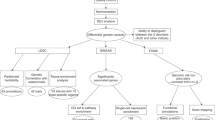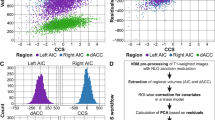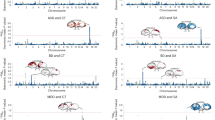Abstract
The widespread comorbidity among psychiatric disorders demonstrated in epidemiological studies1,2,3,4,5 is mirrored by non-zero, positive genetic correlations from large-scale genetic studies6,7,8,9,10. To identify shared biological processes underpinning this observed phenotypic and genetic covariance and enhance molecular characterization of general psychiatric disorder liability11,12,13, we used several strategies aimed at uncovering pleiotropic, that is, cross-trait-associated, single-nucleotide polymorphisms (SNPs), genes and biological pathways. We conducted cross-trait meta-analysis on 12 psychiatric disorders to identify pleiotropic SNPs. The meta-analytic signal was driven by schizophrenia, hampering interpretation and joint biological characterization of the cross-trait meta-analytic signal. Subsequent pairwise comparisons of psychiatric disorders identified substantial pleiotropic overlap, but mainly among pairs of psychiatric disorders, and mainly at less stringent P-value thresholds. Only annotations related to evolutionarily conserved genomic regions were significant for multiple (9 out of 12) psychiatric disorders. Overall, identification of shared biological mechanisms remains challenging due to variation in power and genetic architecture between psychiatric disorders.
This is a preview of subscription content, access via your institution
Access options
Access Nature and 54 other Nature Portfolio journals
Get Nature+, our best-value online-access subscription
$32.99 / 30 days
cancel any time
Subscribe to this journal
Receive 12 print issues and online access
$209.00 per year
only $17.42 per issue
Buy this article
- Purchase on SpringerLink
- Instant access to full article PDF
Prices may be subject to local taxes which are calculated during checkout




Similar content being viewed by others
Data availability
GWAS summary statistics on ADHD, ASD, BIP, ANO, DEP, TS, OCD, alcohol use disorder and SCZ are publicly available for download at the psychiatric genomics consortium website: https://www.med.unc.edu/pgc/download-results/. Genome-wide summary statistics on INS are available at: https://ctg.cncr.nl/software/summary_statistics/. Genome-wide summary statistics on post-traumatic stress disorder and ANX were obtained from the Million Veteran Program (https://www.research.va.gov/mvp/) and transferred through correspondence with Daniel Levey (daniel.levey@yale.edu). All GWAS summary statistics are based on Human Genome Build 37 (GRCh37/hg19). Summary statistics from the cross-trait meta-analysis of 12 psychiatric disorders and of 11 psychiatric disorders excluding SCZ are available at https://ctg.cncr.nl/software/summary_statistics.
Precomputed LD scores were obtained from https://github.com/bulik/ldsc. Single-cell RNA sequencing data used for cell-type analyses were obtained from http://dropviz.org/. Gene information was obtained from the GeneCard database (v5.12.0 Build 702; https://www.genecards.org). Figure 2 and supplementary figure 1 were made with the help of the scientific illustration program BioRender (www.BioRender.com) with subscription including permission to published.
Code availability
All software (and version, where applicable) used to conduct the analyses in this paper are freely available online:
FUMA(v1.4.0) GWAS platform: http://fuma.ctglab.nl/
MAGMA(v.1.10) gene-based and gene property analysis: https://ctg.cncr.nl/software/magma
LAVA(v0.1.0) local genetic correlations: https://ctg.cncr.nl/software/lava
mvGWAMA(v0.0.2) and effective sample size calculation: https://github.com/Kyoko-wtnb/mvGWAMA
Functional categories for stratified heritability (BaselineLD; v2.2): https://alkesgroup.broadinstitute.org/LDSCORE/
Synaptic Gene Ontologies (v1.1) platform: https://www.syngoportal.org
Complex Trait Genetics Virtual Lab platform (beta-0.4): https://view.genoma.io/
MiXeR (v1.3) Analysis: https://github.com/precimed/mixer
References
Momen, N. C. et al. Association between mental disorders and subsequent medical conditions. N. Engl. J. Med. 382, 1721–1731 (2020).
Guo, M. et al. Analysis of disease comorbidity patterns in a large-scale China population. BMC Med. Genomics 12, 177 (2019).
Plana-Ripoll, O. et al. Exploring comorbidity within mental disorders among a Danish National Population. JAMA Psychiatry 76, 259 (2019).
Kessler, R. C. et al. Development of lifetime comorbidity in the World Health Organization World Mental Health Surveys. Arch. Gen. Psychiatry 68, 90 (2011).
Kessler, R. C. et al. Lifetime co-morbidity of DSM-IV disorders in the US National Comorbidity Survey Replication Adolescent Supplement (NCS-A). Psychol. Med. 42, 1997–2010 (2012).
The Brainstorm Consortium. et al. Analysis of shared heritability in common disorders of the brain. Science 360, eaap8757 (2018).
Lee, P. H. et al. Genomic relationships, novel loci, and pleiotropic mechanisms across eight psychiatric disorders. Cell 179, 1469–1482.e11 (2019).
Grotzinger, A. D. et al. Genetic architecture of 11 major psychiatric disorders at biobehavioral, functional genomic and molecular genetic levels of analysis. Nat. Genet. 54, 548–559 (2022).
ReproGen Consortium. et al. An atlas of genetic correlations across human diseases and traits. Nat. Genet. 47, 1236–1241 (2015).
Watanabe, K. et al. A global overview of pleiotropy and genetic architecture in complex traits. Nat. Genet. 51, 1339–1348 (2019).
van Rheenen, W., Peyrot, W. J., Schork, A. J., Lee, S. H. & Wray, N. R. Genetic correlations of polygenic disease traits: from theory to practice. Nat. Rev. Genet. 20, 567–581 (2019).
Shikov, A. E., Skitchenko, R. K., Predeus, A. V. & Barbitoff, Y. A. Phenome-wide functional dissection of pleiotropic effects highlights key molecular pathways for human complex traits. Sci. Rep. 10, 1037 (2020).
Hackinger, S. & Zeggini, E. Statistical methods to detect pleiotropy in human complex traits. Open Biol. 7, 170125 (2017).
Demontis, D. et al. Discovery of the first genome-wide significant risk loci for attention deficit/hyperactivity disorder. Nat. Genet. 51, 63–75 (2019).
Kranzler, H. R. et al. Genome-wide association study of alcohol consumption and use disorder in 274,424 individuals from multiple populations. Nat. Commun. 10, 1499 (2019).
Watson, H. J. et al. Genome-wide association study identifies eight risk loci and implicates metabo-psychiatric origins foranorexia nervosa. Nat. Genet. 51, 1207–1214 (2019).
Purves, K. L. et al. A major role for common genetic variation in anxiety disorders. Mol. Psychiatry 25, 3292–3303 (2020).
Levey, D. F. et al. Reproducible genetic risk loci for anxiety: results from ~200,000 participants in the million veteran program. Am. J. Psychiatry 177, 223–232 (2020).
Grove, J. et al. Identification of common genetic risk variants for autism spectrum disorder. Nat. Genet. 51, 431–444 (2019).
eQTLGen Consortium et al. Genome-wide association study identifies 30 loci associated with bipolar disorder. Nat. Genet. 51, 793–803 (2019).
Jansen, P. R. et al. Genome-wide analysis of insomnia in 1,331,010 individuals identifies new risk loci and functional pathways. Nat. Genet. 51, 394–403 (2019).
Wray, N. R. et al. Genome-wide association analyses identify 44 risk variants and refine the genetic architecture of majordepression. Nat. Genet. 50, 668–681 (2018).
International Obsessive Compulsive Disorder Foundation Genetics Collaborative (IOCDF- GC) and OCD CollaborativeGenetics Association Studies (OCGAS). Revealing the complex genetic architecture of obsessive-compulsive disorder usingmeta-analysis. Mol. Psychiatry 23, 1181–1188 (2018).
Stein, M. B. et al. Genome-wide association analyses of post-traumatic stress disorder and its symptom subdomains in the Million Veteran Program. Nat. Genet. 53, 174–184 (2021).
Trubetskoy, V. et al. Mapping genomic loci implicates genes and synaptic biology in schizophrenia. Nature 604, 502–508 (2022).
Yu, D. et al. Interrogating the Genetic Determinants of Tourette’s Syndrome and Other Tic Disorders Through Genome-Wide Association Studies. Am. J. Psychiatry 176, 217–227 (2019).
Bulik-Sullivan, B. et al. LD score regression distinguishes confounding from polygenicity in genome-wide association studies. Nat. Genet. 47, 291–295 (2015).
Pettersson, E. et al. Genetic influences on eight psychiatric disorders based on family data of 4 408 646 full and half-siblings, and genetic data of 333 748 cases and controls. Psychol. Med. 49, 1166–1173 (2019).
Grotzinger, A. D. et al. Genomic structural equation modelling provides insights into the multivariate genetic architecture of complex traits. Nat. Hum. Behav. 3, 513–525 (2019).
Cuellar-Partida, G. et al. Complex-Traits Genetics Virtual Lab: A community-driven web platform for post-GWAS analyses. Available at bioRxiv, https://doi.org/10.1101/518027 (2019).
International COPD Genetics Consortium. et al. Genetic overlap of chronic obstructive pulmonary disease and cardiovascular disease-related traits: a large-scale genome-wide cross-trait analysis. Respir. Res. 20, 64 (2019).
The International IBD Genetics Consortium (IIBDGC). et al. Analysis of five chronic inflammatory diseases identifies 27 newassociations and highlights disease-specific patterns at shared loci. Nat. Genet. 48, 510–518 (2016).
Lesseur, C. et al. Genome-wide association meta-analysis identifies pleiotropic risk loci for aerodigestive squamous cell cancers. PLoS Genet. 17, e1009254 (2021).
Li, Y. R. et al. Meta-analysis of shared genetic architecture across ten pediatric autoimmune diseases. Nat. Med. 21, 1018–1027 (2015).
Rashkin, S. R. et al. Pan-cancer study detects genetic risk variants and shared genetic basis in two large cohorts. Nat. Commun. 11, 4423 (2020).
Jansen, I. E. et al. Genome-wide meta-analysis identifies new loci and functional pathways influencing Alzheimer’s disease risk. Nat. Genet. 51, 404–413 (2019).
Watanabe, K., Taskesen, E., van Bochoven, A. & Posthuma, D. Functional mapping and annotation of genetic associations with FUMA. Nat. Commun. 8, 1826 (2017).
de Leeuw, C. A., Mooij, J. M., Heskes, T. & Posthuma, D. MAGMA: Generalized gene-set analysis of GWAS data. PLoS Comput. Biol. 11, e1004219 (2015).
Evangelou, E. & Ioannidis, J. P. A. Meta-analysis methods for genome-wide association studies and beyond. Nat. Rev. Genet. 14, 379–389 (2013).
Zhao, H. & Nyholt, D. R. Gene-based analyses reveal novel genetic overlap and allelic heterogeneity across five major psychiatric disorders. Hum. Genet. 136, 263–274 (2017).
Hammerschlag, A. R., de Leeuw, C. A., Middeldorp, C. M. & Polderman, T. J. C. Synaptic and brain-expressed gene sets relate to the shared genetic risk across five psychiatric disorders. Psychol. Med. 50, 1695–1705 (2020).
Clifton, N. E. et al. Developmental profile of psychiatric risk associated with voltage-gated cation channel activity. Biol. Psychiatry 90, 399–408 (2021).
O’Connell, K. S., McGregor, N. W., Lochner, C., Emsley, R. & Warnich, L. The genetic architecture of schizophrenia, bipolar disorder, obsessive-compulsive disorder and autism spectrum disorder. Mol. Cell. Neurosci. 88, 300–307 (2018).
Werme, J., van der Sluis, S., Posthuma, D. & de Leeuw, C. A. An integrated framework for local genetic correlation analysis. Nat. Genet. 54, 274–282 (2022).
Liberzon, A. et al. Molecular signatures database (MSigDB) 3.0. Bioinformatics 27, 1739–1740 (2011).
The GTEx Consortium. et al. The Genotype-Tissue Expression (GTEx) pilot analysis: Multitissue gene regulation in humans. Science 348, 648–660 (2015).
Saunders, A. et al. Molecular diversity and specializations among the cells of the adult mouse brain. Cell 174, 1015–1030 (2018).
Koopmans, F. et al. SynGO: An evidence-based, expert-curated knowledge base for the synapse. Neuron 103, 217–234 (2019).
ReproGen Consortium. et al. Partitioning heritability by functional annotation using genome-wide association summary statistics. Nat. Genet. 47, 1228–1235 (2015).
Nishino, J., Ochi, H., Kochi, Y., Tsunoda, T. & Matsui, S. Sample size for successful genome-wide association study of major depressive disorder. Front. Genet. 9, 227 (2018).
Holland, D. et al. Beyond SNP heritability: Polygenicity and discoverability of phenotypes estimated with a univariate Gaussian mixture model. PLoS Genet. 16, e1008612 (2020).
Higgins, J. P. T. Measuring inconsistency in meta-analyses. Brit. Med. J. 327, 557–560 (2003).
Ong, C.-T. & Corces, V. G. Enhancer function: new insights into the regulation of tissue-specific gene expression. Nat. Rev. Genet. 12, 283–293 (2011).
Stelzer, G. The GeneCards Suite: From gene data mining to disease genome sequence analyses. Curr. Protoc. Bioinformatics. 54, 1.30.1–1.30.33 (2016).
Nagel, M., Watanabe, K., Stringer, S., Posthuma, D. & Van Der Sluis, S. Item-level analyses reveal genetic heterogeneity in neuroticism. Nat. Commun. 9, 905 (2018).
Acknowledgements
C.R., D.P. and S.v.d.S were funded by Netherlands Organization for Scientific Research (NWO; Gravitation: BRAINSCAPES: A Roadmap from Neurogenetics to Neurobiology; grant 024.004.012 to D.P.). P.R.J. was funded by the Netherlands Organization for Scientific Research (ZonMW VENI-09150162010138 to P.R.J.). D.P., J.W. and C.d.L. were funded by the Netherlands Organization for Scientific Research (NWO VICI 453-14-005 to D.P.), and M.N., D.P., J.W. and C.d.L. were funded a European Research Council advanced grant (ERC-2018-AdG GWAS2FUNC 834057 to D.P.). The analyses were carried out on the Genetic Cluster Computer, which is financed by the Netherlands Scientific Organization (NWO 480-05-003), VU University (Amsterdam, the Netherlands) and the Dutch Brain Foundation and hosted by the Dutch National Computing and Networking Services SurfSARA. This research was conducted using the UK Biobank resource under application number 16406 and is based in part on data from the Million Veteran Program, Office of Research and Development, Veterans Health Administration, supported by awards CSP 575B and Merit 1|01CX001849.e. We thank the numerous participants, researchers and staff from many studies who collected and contributed to the data. In particular, we would like to express our gratitude to all UK Biobank and Million Veteran Program participants who have been so generous to share their data for analysis. Figure 2 and Supplementary Figure 1 were created with BioRender.com. These figures were, in part, adapted from the ‘Central Dogma’, ‘Expression of ACE2 Receptor in Human Host Tissues’ and ‘Notch Signaling Pathway’ templates by BioRender.com (2020) and can be retrieved from https://app.biorender.com/biorender-templates.
Author information
Authors and Affiliations
Contributions
S.v.d.S and D.P. conceived of the study. C.R. and M.N. performed the main analyses. J.W. and C.d.L. were consulted on LAVA analyses and results. J.G., M.B.S, D.L. and R.P. conducted the original study on PTSD and provided early access to the PTSD and ANX summary statistics. C.R., M.N. and S.v.d.S. wrote the paper. All authors discussed the results and commented on the paper.
Corresponding author
Ethics declarations
Competing interests
C.d.L. is funded by Hoffman-La Roche. The other authors declare no competing interests.
Peer review
Peer review information
Nature Genetics thanks Na Cai and Duncan Palmer for their contribution to the peer review of this work. Peer reviewer reports are available.
Additional information
Publisher’s note Springer Nature remains neutral with regard to jurisdictional claims in published maps and institutional affiliations.
Supplementary information
Supplementary Information
Table of contents, Supplementary Figures 1–27, Notes 1–7 and References.
Supplementary Table
Supplementary Tables 1–20
Rights and permissions
Springer Nature or its licensor (e.g. a society or other partner) holds exclusive rights to this article under a publishing agreement with the author(s) or other rightsholder(s); author self-archiving of the accepted manuscript version of this article is solely governed by the terms of such publishing agreement and applicable law.
About this article
Cite this article
Romero, C., Werme, J., Jansen, P.R. et al. Exploring the genetic overlap between twelve psychiatric disorders. Nat Genet 54, 1795–1802 (2022). https://doi.org/10.1038/s41588-022-01245-2
Received:
Accepted:
Published:
Issue Date:
DOI: https://doi.org/10.1038/s41588-022-01245-2
This article is cited by
-
Systematic dissection of pleiotropic loci and critical regulons in excitatory neurons and microglia relevant to neuropsychiatric and ocular diseases
Translational Psychiatry (2025)
-
The overlapping genetic architecture of psychiatric disorders and cortical brain structure
Nature Mental Health (2025)
-
The Transdiagnostic Connectome Project: an open dataset for studying brain-behavior relationships in psychiatry
Scientific Data (2025)
-
Genetic influences on antidepressant side effects: a CYP2C19 gene variation and polygenic risk study in the Estonian Biobank
European Journal of Human Genetics (2025)
-
Leveraging pleiotropy for the improved treatment of psychiatric disorders
Molecular Psychiatry (2025)



